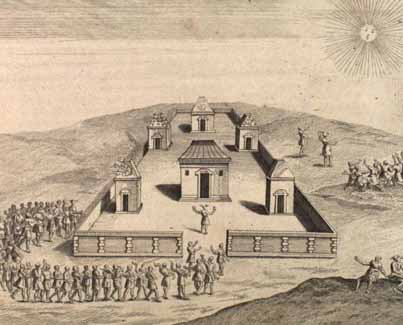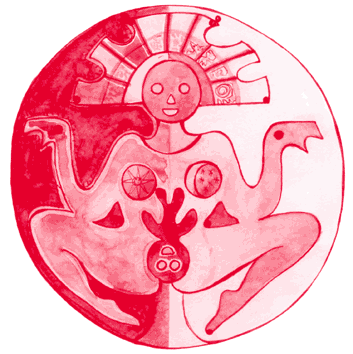 |
 |
 |
 |
 |
 |
 |
 |
 |
 |
 |
 |
 |
 |
 |
 |
 |
 |
 |
 |
 |
 |
 |
 |
 |
 |
 |
 |
 |
|
|
 |
|
|
|
 |
|
|
|
The Inca, as many other pre-Columbian societies, worshiped multiple gods. The highest was the Sun, a male god who the Inca believe to be children of. They also have other dieties, most taking the form of natural phenomon and features; such as the Moon, Earth, Thunder and Sea. The Inca built grand temples for their gods, where they would worship and perform various rituals. Over the course of a year, the Inca had a festival for each of the twelve months, celebrating and honoring different gods and events. Men most often worshiped the sun, because he was depicted as male and women would worship either the Moon or the Earth, both female gods, depending on where they were geographically in the empire. Within the Inca system of religion, men and women had very different roles for the most part. Men held the positions of power, while women played a more minor role. |
|
|
|
In the Inca religious system, men were priests and held the power within the institution. Families passed on this position and power from father to son through the generations. Women did not serve as leaders of the faith, but rather many became a part of the clergy called aclla-cuna, Chosen Women. These women served as “...handmaidens of Inti, the Sun.” Girls were selected between the ages of eight and fifteen, in order to insure their virginity. The detail over exactly what took place following a girl being taken into the Chosen Women is debated among historians. The Inca historian, Garcilaso, tells of girls being divided into smaller group, each with an older Chosen Woman at its head. They then moved into large complexes where they were kept away from Inca society. It was here they performed their duties. They wove garments for the high priests of the Incas and made food and drink for large ceremonies held in honor of the Sun. Garcilaso claims the women lived forever in seclusion, remaining virgins until the end of their days and the only very few people every saw them. However, there is disagreement about these facts. Alonso Ramos Gavilán, an Augustinian friar, makes the argument that girls were only kept secluded in the convents until age sixteen, when they were married off to powerful men in the community whom the Inca favored. |
|
|
 |
|
|
|
|
|
House Chosen Women may have lived in. |
|
|
|
|
|
|
He also claims the women were used as sacrifices at times for religious festivals. Another Father, Ramón y Zamora, tells of women being brought together every few years so the Inca may chose four or five women who were always of noble birth to become Brides of the Sun and retain their virginity for the rest of their lives. The remaining women, who the Inca or his chief priest did not take for themselves, were given to men of the community. Polo de Ondegardo, holds yet another account of how the Chosen Women’s lives were spent. He describes how girls were taken between ages eight and nine and educated by older women in womanly matters. They then become the wives of favored men or the Inca himself, a matron and take over the education of new girls or sacrificial beings during religious rites. In addition to being a member of the clergy, women were also shamen working as healers through their knowledge of the local vegetation. |
|
|
|
While women may not have had a very large role in the religious institutions of the Inca culture, they did play an important part in the belief systems of these ancient people. The Inca people worshiped Mother Earth, Pachamama, which was a female god. Throughout the Pruvian region, Pachamama is depicted in several ways, but always as the giver of life to both men and women. However she gave special knowledge to women, teaching them how to raise future Inca. Pachamama gave women something to come together around and have in common, something that was theirs. It must have been a very powerful feeling, knowing a woman gave life to all things and you, as a woman, were her daughter. Besides being supernatural beings, women played a role in the myths that founded many of the Inca beliefs.Women are found multiple times in multiple stories surronding the Inca beliefs. Within the Huarochirí Manuscript, written during the colonial period of the Andes, outlines the pre-colonial traditions and beliefs of the people. There are rituals, as well as myths that are the basis of much of the Inca religious thought. Women play an important role in many of these, acting as aids to many of the gods. Women can be found in different areas and in differing capacities within Inca beliefs, showing they did play a role of some kind in the religious life of the Inca Empire. |
|
|
|
 |
|
|
|
|
|
A depiction of Pachamama, Mother Earth |
|
|
|
|
|
End Notes
1 Inca Religion,
5 2 Ancient Civ, 408
3 Ancient Civ, 409-10
4 Ancient Civ, 410
5 Ancient Civ, 411
6 Empire, 56
7 Empire, 43
8 Empire, 45
9 Haurochiri, 1 |
|
|
|
|
|
 |
|
|
 |
|
|
|
|
 |
|
|
|
|
|
|
|


